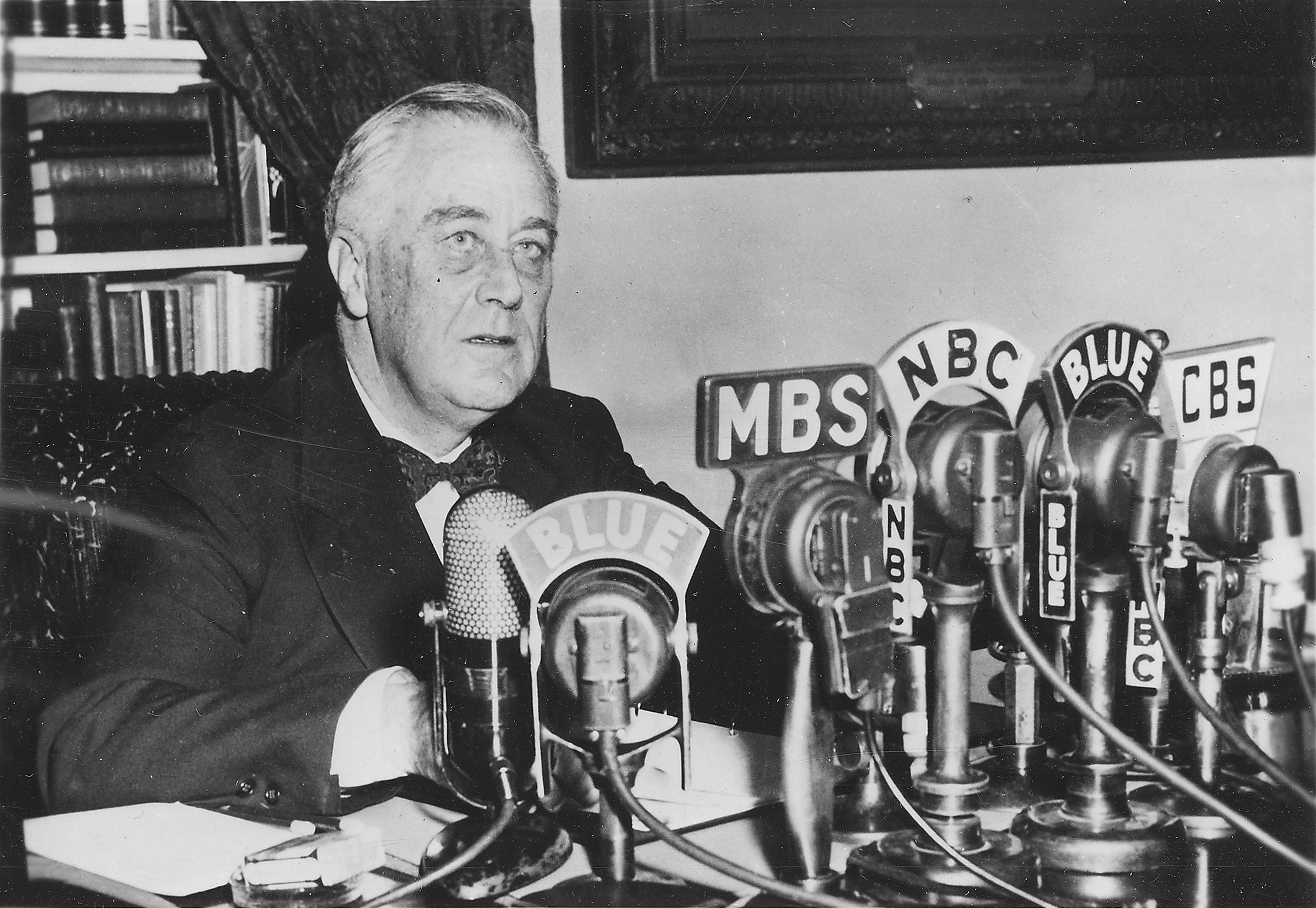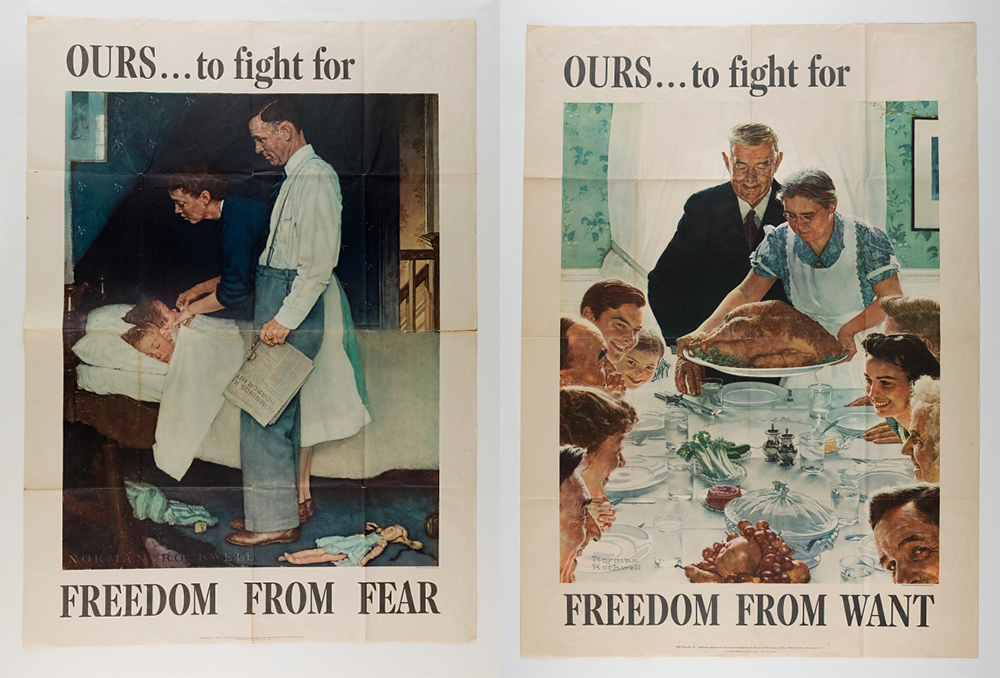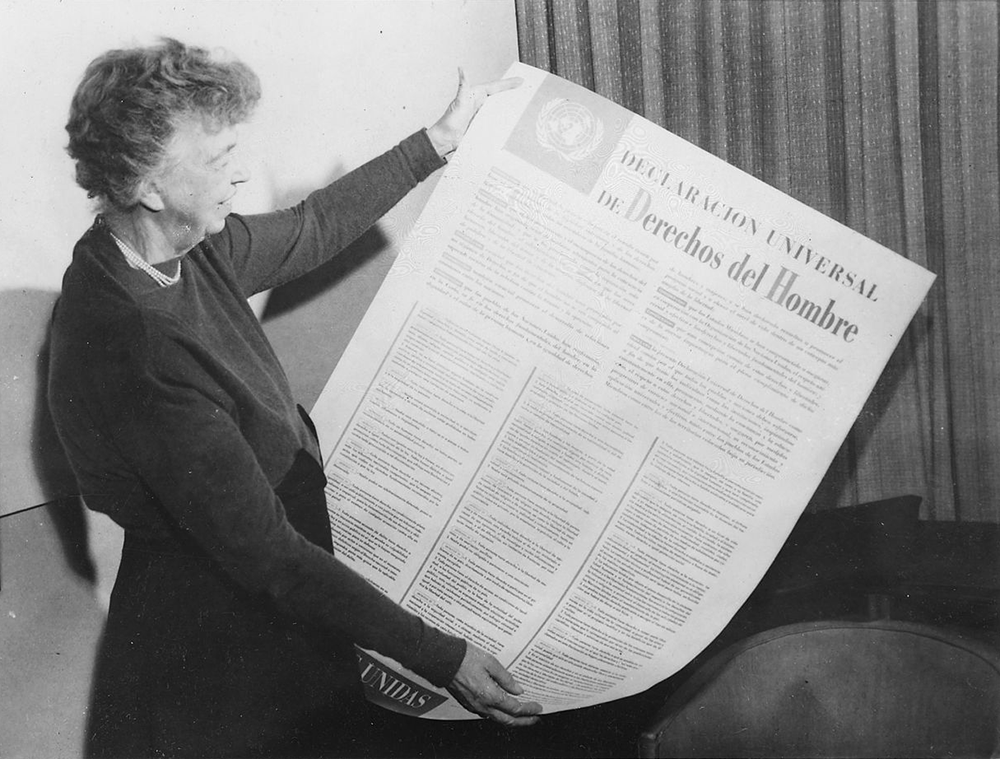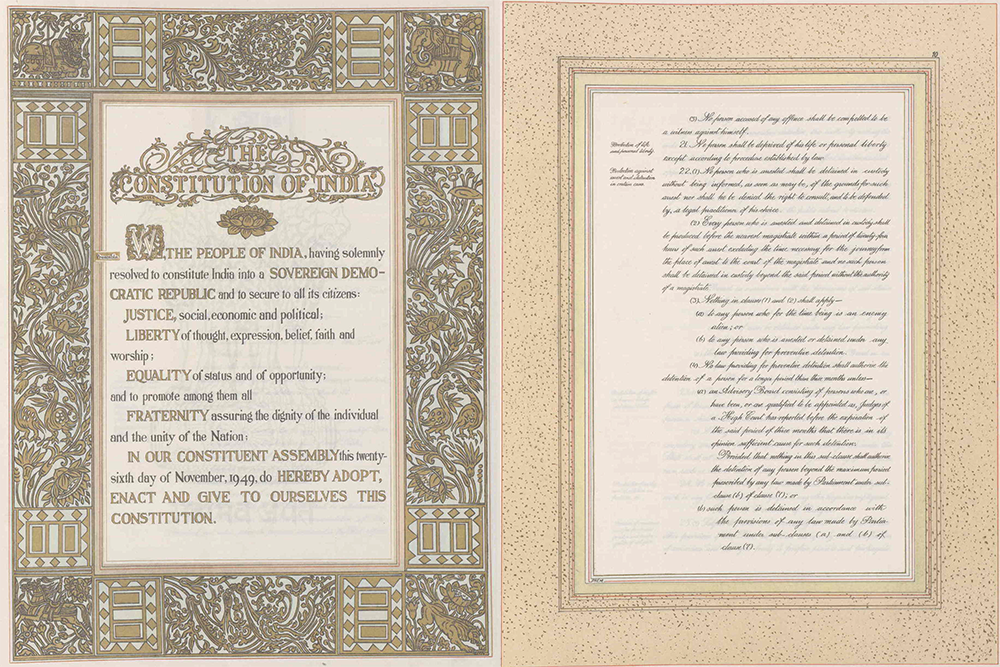https://www.laphamsquarterly.
~~ recommended by emil karpo ~~

President Franklin D. Roosevelt in Washington, DC, January 11, 1944. National Archives and Record Administration, Franklin D. Roosevelt Library.
A few days after Franklin D. Roosevelt’s State of the Union address on January 11, 1944, New York Herald Tribune columnist Walter Lippmann wrote that an unnamed Republican congressman had dismissed the president’s message as “a campaign document.” He was referring specifically to the president’s recommendations for stabilizing the economy: a new tax bill, a price-control law for food, currency stabilization measures, and a national service law.
If the congressman is right…he ought then ask himself whether perchance it may not be a good campaign document. It would not be the first time in this war that a program of victory by blood, sweat, and tears has proved to be a better way of retaining the people’s confidence than a menu of pap, applesauce, and eyewash.
Lippmann seems to have had a hunch that Roosevelt would defeat Thomas Dewey and win a fourth presidential term on this platform. But he didn’t immediately predict that what Roosevelt presented in his State of the Union would launch a global movement of social and economic rights arguably as influential as his New Deal legacy and certainly more enduring than his wartime effort to end unemployment and price increases. There are eight tenets of the Second Bill of Rights Roosevelt proposed in his speech:
The right to a useful and remunerative job in the industries, or shops or farms or mines of the nation;
The right to earn enough to provide adequate food and clothing and recreation;
The right of every farmer to raise and sell his products at a return which will give him and his family a decent living;
The right of every businessman, large and small, to trade in an atmosphere of freedom from unfair competition and domination by monopolies at home or abroad;
The right of every family to a decent home;
The right to adequate medical care and the opportunity to achieve and enjoy good health;
The right to adequate protection from the economic fears of old age, sickness, accident and unemployment;
The right to a good education.
During the 2016 campaign, Bernie Sanders called FDR’s 1944 State of the Union speech “one of the most important speeches ever made by a president.” The tragedy is that these rights proliferated nearly everywhere but at home—and, aside from some bright spots, any that did exist in the U.S. now are eroding. The Bill was truly radical both then and now—almost as radical as the original Bill of Rights ratified in 1789. And the radical promise of the Second Bill of Rights goes unfulfilled to this day.

Some of FDR’s own policies failed to live up to his ideals. His administration’s commitment to unemployment insurance meant that universal health coverage was sidelined. He never provided economic relief to victims of lynching or to Japanese Americans whose property was lost, stolen, or seized. But Roosevelt’s New Deal programs pushed the Supreme Court to establish a new rubric for economic security in an era of fascism and authoritarianism, even if some Americans were excluded from the benefits.
T
he Second Bill of Rights was both a sleeper and a hit. The day after Roosevelt’s speech, the Wall Street Journal wrote that “we hope—indeed we assume—that the new bill would be in addition to and not a replacement of the existing one.” Hardly a ringing endorsement, but still surprising for a pro-business publication. On February 26, 1944, the New York Amsterdam News called it “the greatest and most realistic of the Bills of Rights. Hence the loud silence that greeted it.” For labor groups, it became not just a platform but a cri de coeur. It even became a platform during Truman’s 1948 campaign, though the Daily Worker was skeptical of his commitment: “In the mouth of FDR, this ‘Second Bill of Rights’ had a splendid ring, because people knew he meant it and was fighting for it. In the mouth of President Truman, it sounded stuffy and dead.”
Even though the president urged Congress to consider vesting citizens with eight new rights, a Second Bill of Rights was never formally introduced in Congress and never was interpreted by the Supreme Court. Promises of basic human dignities—such as guaranteeing the right to housing or to be free from monopoly power, for example—historically have not blended well with capitalist economies. Elite American political culture traditionally has favored a form of Adam Smith individualism in which the pursuit of self-interest, the sanctity of private property, and the right to be left alone are paramount. The state existed to protect these rights, not to create new ones—a delineation between negative and positive liberties that Isaiah Berlin explored in “Two Concepts of Liberty,” a 1958 lecture he delivered at the University of Oxford and later published as a pamphlet.
Well before Berlin—whose work did not focus on the United States—the Civil War changed the perception that the country would not be especially receptive to positive rights. During Reconstruction, economic rights involving labor and trade were established under the Fourteenth Amendment’s due-process clause. The Civil Rights Act of 1866 guaranteed to “citizens of every race and color…the same right…as is enjoyed by white citizens…to make and enforce contracts, to sue…purchase, lease, sell, hold and convey real and personal property.” While these economic rights were established to protect individuals, corporations sought to claim them. In the backlash following Reconstruction, African Americans were banned from working in textile mills and Jim Crow laws expanded. Meanwhile, workers demanded better conditions and wages as labor unions proliferated or consolidated. Yet many of these rights languished until the progressive movement in the U.S. when President Woodrow Wilson passed a series of social and economic reforms: the creation of the Federal Reserve Board, the passage of the Clayton Antitrust Act, the establishment of workers’ compensation, and improved credit for farmers. These created a powerful precedent via the New Deal, which solidified some basic guarantees for American citizens, such as the right to unionize and bargain collectively. That effort paved the way for Roosevelt’s crystallization of the principles of economic justice that made up the Second Bill of Rights.

After Roosevelt’s death in 1945, his ideas informed the Universal Declaration of Human Rights. A UNESCO Philosophers’ Committee began drafting it in 1946, and then the UN Commission on Human Rights took over. According to Gordon Brown’s The Universal Declaration of Human Rights in the 21st Century, it was decided before it was passed in 1948—shortly after the establishment of the United Nations—that the document would be a declaration rather than a treaty with both civil and political rights and social, economic, and cultural rights. Drafted as a “common standard of achievement for all peoples and nations,” the declaration provides the earliest modern legal authority for social and economic rights globally. It was the foundation for two covenants adopted by the UN General Assembly: the International Covenant on Civil and Political Rights and the International Covenant on Economic, Social and Cultural Rights, which, along with the declaration, are known as the International Bill of Rights. The two covenants are binding in countries that have ratified them. Treaties, such as the Convention of the Elimination of All Forms of Discrimination Against Women and the Convention Against Torture and Other Cruel, Inhuman or Degrading Treatment or Punishment, round out international human rights jurisprudence. Some instruments, like the Universal Declaration of Human Rights, are “soft law”—not strictly binding, but respected as norms in international law.
Eleanor Roosevelt chaired the committee that made the United States among the first countries to commit to protecting such rights. The leading role the U.S. took here is especially notable, given its reluctance to ratify other global agreements, such as the Convention on the Rights of the Child. In 1961 the Council of Europe, an international organization dedicated to promoting human rights, adopted the European Social Charter. Forty-three governments have ratified either this charter or the revision adopted in 1996. The treaty protects the right to work; the right to organize; the right to bargain collectively; the right to social security; the right to social and medical assistance; the right to social, legal, and economic protection of the family; and the right to protection and assistance for migrant workers and their families. Ultimately, the International Covenant on Economic, Social, and Cultural Rights was ratified by 167 countries—but not by the United States. That the covenant did not establish a functioning complaint mechanism until 2012 demonstrates the problems with enforcing these global agreements, which are meaningfully distinct from formal adoptions of such rights or pledges to protect citizens.
M
any constitutions outside the U.S. recognize aspects of Roosevelt’s Second Bill of Rights. As Cass Sunstein notes in The Second Bill of Rights: FDR’s Unfinished Revolution and Why We Need It More Than Ever, the South African and Iraqi constitutions guarantee a right to education, health care, social security, and housing. Finland’s establishes that everyone has “the right to basic sustenance.” Norway’s requires the state “to create conditions enabling every person capable of work to earn a living by his work.” In Spain’s constitution, ratified thirteen years before Roosevelt’s speech, the nation “shall assure to every worker the conditions necessary for a fitting existence,” including “economic sufficiency through adequate and periodically updated pensions” to citizens in old age. Constitutions in Portugal, Brazil, Poland, Uruguay, Paraguay, Ukraine, Romania, Bulgaria, Hungary, Russia, Peru, and Egypt all recognize some form of Roosevelt’s economic rights. Mexico’s 1917 constitution included social-welfare provisions years before the Second Bill of Rights was proposed. U.S. state constitutions recognize aspects of the bill, such as the right to education.
The ground rules vary on enforcement. Some countries classify these rights as mere principles that are not legally enforceable. Violations of the International Covenant on Economic, Social, and Cultural Rights are tracked by the Committee on Economic, Social, and Cultural Rights, but courts do not play a role. As Sunstein explains, Roosevelt created the Second Bill of Rights as a document to be protected politically, not judicially, yet nations that embrace its tenets benefit from judicial enforcement. South African courts protect these rights as necessary without requiring protection for each person who suffers (to the chagrin of some). In India the rights are constitutional tenets with legislative enforcement. Article 21 of India’s constitution is a catchall right-to-life or personal-liberty clause that includes the right to work, health, education, and privacy and against public hanging and solitary confinement. It even protects the right to write and publish a book while in jail. In the U.S., states such as New York balance commitment to the rights with both judicial intervention and legislative policy.

Still, going through the courts to enforce these constitutional provisions can take years to get practical results, if at all. In 2000 the South African Constitutional Court recognized that the social and economic rights of about nine hundred plaintiffs living in a squatter settlement outside Cape Town had been violated because there was no plan to offer “temporary relief” to those without shelter. The decision was rooted in two sections of the South African Constitution: Section 26, which asserts that “everyone has the right to have access to adequate housing,” and Section 28, which protects a child’s right to basic shelter. Unfortunately, Irene Grootboom, the activist who brought the case, died before moving into adequate housing, and it took years after the ruling for the government to house her community.
In the United States, social and economic rights have experienced historical failures. Following the progressive era (1890–1920) and the New Deal, rights waned until the 1950s and 1960s, when a series of cases upheld equal justice for the poor. In 1956 the Supreme Court ruled that states were required to provide poor appellants trial transcripts for free. Seven years later, the court held that the Constitution requires the state to pay for defense attorneys in criminal cases. The same year, the court again ruled that the poor be offered an attorney for their first appeal involving a criminal conviction. These rights endure. When President Richard Nixon was elected, the justices he appointed slowed down progress on social and economic rights once again. In one ruling, the court asserted that education was not a fundamental constitutional right, even though this conflicts with some state constitutions.
Before President Trump was elected, a movement had begun to emerge that favored social and economic rights grounded in state and local politics. Beginning with the financial crisis of 2008 and the passage of the Affordable Care Act, legal and political discourse shifted for the first time since the 1960s from questions of civil liberties toward social and economic rights. The Supreme Court twice affirmed the ACA. In 2017 New York governor Andrew Cuomo signed a bill that offered students from families with incomes of up to $125,000 a tuition-free education at public colleges and universities if they live in the state for the same number of years they participate in the program. The minimum wage is the latest salvo in the battle over economic rights, as illustrated in the Fight for $15 campaign.
This movement has increased urgency in the Trump era. Labor laws are poorly enforced, especially in southern states, and “right to work” laws—which ensure employees cannot be forced to join a union—proliferate. In a case before the Supreme Court this term, Janus v. American Federation of State, County, and Municipal Employees, the court may find that a requirement for a government employee to pay union dues is a violation of his or her free-speech rights. These developments have spurred a fight for the robust social and economic safety net that Roosevelt envisioned.
I
n his column on Roosevelt’s 1944 State of the Union, Lippmann wrote, “We all know that Mr. Roosevelt is just about the shrewdest and most successful practical politician of our time. Nobody has ever doubted that.”
Roosevelt’s astuteness was on display when he proposed the Second Bill of Rights, even if Lippmann didn’t devote a sentence to it and Roosevelt would never see these rights formally adopted. It was a gesture directed at dictators and bullies, authoritarians and tyrants who have been thwarted from exploiting the weakest citizens because the law preserved fundamental human dignities—at least in the best cases. Yet human frailty and callousness, bureaucracies, and lack of resources continue to mitigate the practical effect of these rights. But then Roosevelt was not one to surrender. If he were, he would not have campaigned so passionately for the cause.
Read more on the law in Rule of Law, the spring 2018 issue of Lapham’s Quarterly.
No comments:
Post a Comment